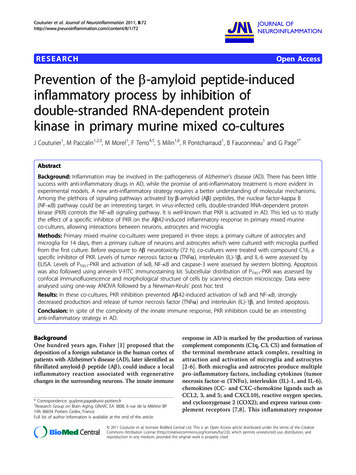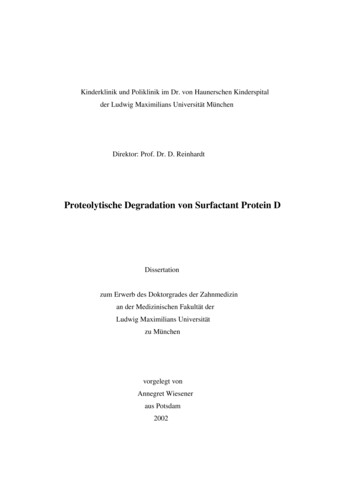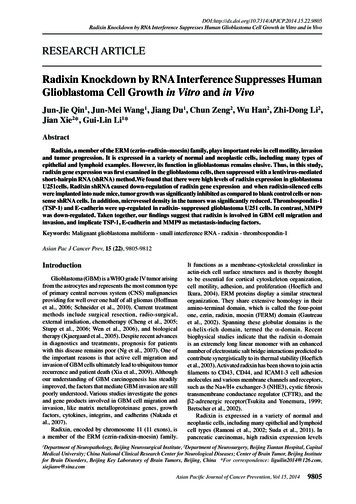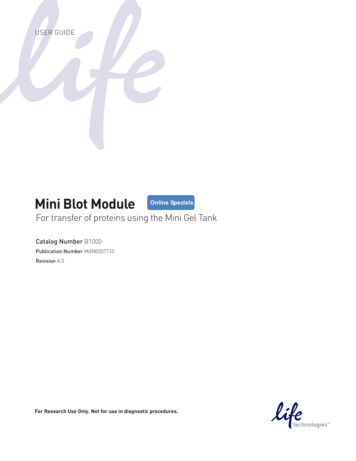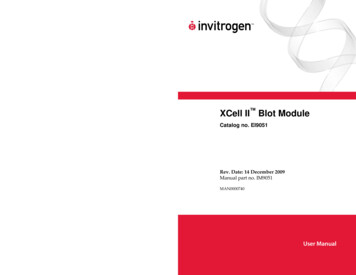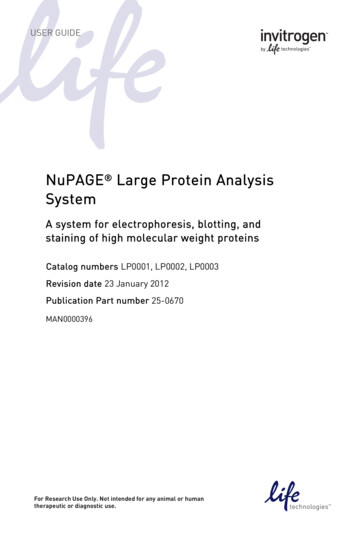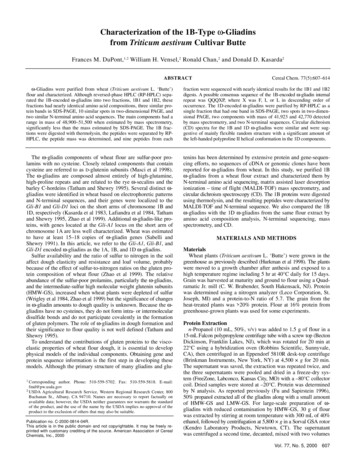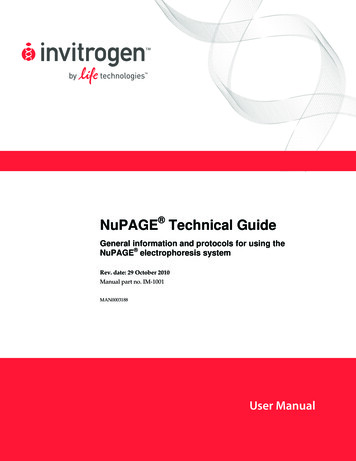
Transcription
Instruction ManualNuPAGE Technical GuideGeneral information and protocols for using the NuPAGE electrophoresis systemVersion EOctober 1, 2003IM-1001
2
Table of ContentsTable of Contents .3General Information.5NuPAGE Gel Specifications .6Description of the NuPAGE Electrophoresis System.7Preparing Samples.11Preparing Running Buffer.14Electrophoresis of NuPAGE Gels .17Silver Staining .20Coomassie Staining.24Gel Drying .28Western Blotting .31Using ZOOM Gels .37Calibrating Protein Molecular Weight .39Troubleshooting.42Accessory Products.45Recipes .47Technical Service .51Purchaser Notification .53References.543
4
General InformationPurpose of theGuideThe NuPAGE Technical Guide contains information about the NuPAGE Electrophoresis System and is intended to supplement the NuPAGE Bis-TrisGel Instruction Card (IM-8042) and the NuPAGE Tris-Acetate Gel InstructionCard (IM-1025). Complete protocols for sample preparation, buffer preparation,electrophoresis, staining, and blotting are provided in this guide.To request the Instruction Cards or for additional information, contact TechnicalService (see page 51) or you may download the manuals from our web site atwww.invitrogen.com.For description of the NuPAGE electrophoresis system, see page 7.Storage and ShelflifeStore NuPAGE Novex Bis-Tris Gels at 4-25 C and NuPAGE Novex TrisAcetate Gels at 4 C.The NuPAGE Novex Bis-Tris Gels have a shelf life of 12 months when storedat 4-25 C.The NuPAGE Novex Tris-Acetate Gels have a shelf life of 8 months whenstored at 4 C.Do not freeze NuPAGE Gels.Using expired gels or improperly stored gels may result in poor bandresolution.Handling the GelsGels are individually packaged in clear pouches with 10 ml of PackagingBuffer. The Packaging Buffer contains low levels of residual acrylamidemonomer and 0.02% sodium azide. Gloves should be worn at all time whenhandling gels.Warning: This product contains a chemical (acrylamide) known to the state ofCalifornia to cause cancer. To obtain a MSDS, see page 51.5
NuPAGE Gel SpecificationsSpecificationsRecommendedLoading VolumesGel Matrix:Acrylamide/BisacrylamideGel Thickness:1.0 mmGel Size:8 cm x 8 cmCassette Size:10 cm x 10 cmCassette Material:Styrene Copolymer (recycle code 7)Sample Well Configuration:1, 9, 10, 12, 15, 17-well, 2D-well, and IPG wellThe recommended loading volumes and protein load per band by the detectionmethod are provided in the table below.Note: The 9- and 17-wells are compatible with any eight-channel pipette usedfor loading samples from 96-well plates. An additional lane is included forloading protein molecular weight standard.Well Types1 well2D wellIPG well9 well10 well12 well15 well17 well6Maximum LoadVolumeCoomassie StainingSilver StainingImmunoblotting700 µl12 µg/band1.0 mm1.5 mm400 µl600 µl12 µg/bandScale your sampleload for thesensitivity of yoursilver staining kit.1.0 mm7 cm IPG StripN/AScale yoursample loadaccording to thesensitivity ofyour detectionmethod.1.0 mm28 µl0.5 µg/band1.0 mm1.5 mm25 µl37 µl0.5 µg/band1.0 mm20 µl0.5 µg/band1.0 mm1.5 mm15 µl25 µl0.5 µg/band1.0 mm15 µl0.5 µg/band1.0 mmMaximum Protein Load Per Band by Detection MethodFor use with theSilverQuest orSilverXpress SilverStaining Kits, werecommend aprotein load of1 ng/band.
Description of the NuPAGE Electrophoresis SystemIntroductionThe NuPAGE Bis-Tris Electrophoresis System is a revolutionary neutral pH,discontinuous SDS-PAGE, pre-cast polyacrylamide mini-gel system. The neutralpH 7.0 environment during electrophoresis results in maximum stability of bothproteins and gel matrix, providing better band resolution than other gel systems(see Advantages of the NuPAGE Electrophoresis System, below).The Laemmli system is the most widely used SDS-PAGE method for separatinga broad range of proteins (Laemmli, 1970). The highly alkaline operating pH ofthe Laemmli system may cause band distortion, loss of resolution, or artifactbands. The major causes of poor band resolution with the Laemmli system are:Advantages of theNuPAGE ElectrophoresisSystemNuPAGE ElectrophoresisSystemComponents Hydrolysis of polyacrylamide at the high gel casting pH of 8.7 resulting in ashort shelf life of 4-6 weeks Chemical modifications such as deamination and alkylation of proteins dueto the high pH (9.5) of the separating gel Reoxidation of reduced disulfides from cysteine containing proteins as theredox state of the gel is not constant Cleavage of Asp-Pro bond of the proteins when heated at 100 C in theLaemmli sample buffer, pH 5.2 (Kubo, 1995).The operating neutral pH of the NuPAGE Gels and buffers provide followingadvantages over the Laemmli system: Longer shelf life of 8-12 months due to improved gel stability (see page 5) Improved protein stability during electrophoresis at neutral pH resulting insharper band resolution and accurate results (Moos et al, 1998) Complete reduction of disulfides under mild heating conditions (70 C for10 minutes) and absence of cleavage of asp-pro bonds using the NuPAGE LDS Sample buffer (pH 7.0 at 70 C) Reduced state of the proteins maintained during electrophoresis andblotting of the proteins by the NuPAGE AntioxidantThe NuPAGE Electrophoresis System consists of: NuPAGE Novex Bis-Tris [Bis (2-hydroxyethyl) imino-tris (hydroxymethyl)methane-HCl] Pre-Cast Gels for separating small to mid-size molecular weightproteins NuPAGE Novex Tris-Acetate Pre-Cast Gels for separating large molecular weightproteins NuPAGE LDS (Lithium dodecyl sulfate) Sample Buffer NuPAGE Reducing Agent NuPAGE Antioxidant NuPAGE MES [2-(N-morpholino) ethane sulfonic acid] SDS or MOPS [3-(Nmorpholino) propane sulfonic acid] SDS Running Buffer for NuPAGE Novex BisTris Gels NuPAGE Tris-Acetate SDS Running Buffer for NuPAGE Novex Tris- AcetateGels NuPAGE Transfer Buffer for blotting of NuPAGE Novex Pre-Cast GelsContinued on next page7
Description of the NuPAGE Electrophoresis System, ContinuedNuPAGE Bis-TrisDiscontinuousBuffer SystemNuPAGE TrisAcetateDiscontinuousBuffer SystemSeparation Rangeof ProteinsThe NuPAGE Bis-Tris discontinuous buffer system involves three ions: Chloride (-) is supplied by the gel buffer and serves as a leading ion due toits high affinity to the anode as compared to other anions in the system. Thegel buffer ions are Bis-Tris and Cl- (pH 6.4). MES or MOPS (-) serves as the trailing ion. The running buffer ions are Tris ,MOPS-/MES-, and dodecylsulfate (-) (pH 7.3-7.7). Bis-Tris ( ) is the common ion present in the gel buffer and running buffer.The combination of a lower pH gel buffer (pH 6.4) and running buffer (pH7.3-7.7) results in a significantly lower operating pH of 7 duringelectrophoresis.The NuPAGE Tris-Acetate discontinuous buffer system involves three ions: Acetate (-) is supplied by the gel buffer and serves as a leading ion due toits high affinity to the anode as compared to other anions in the system.The gel buffer ions are Tris and Acetate- (pH 7.0). Tricine (-) serves as the trailing ion from the running buffer. The runningbuffer ions are Tris , Tricine-, and dodecylsulfate (-) (pH 8.3). Tris ( ) is the common ion present in the gel buffer and running buffer. TheTris-Acetate system also operates at a significantly lower operating pH of8.1 during electrophoresis.The NuPAGE Gels have a wider range of separation on a single gel and alsoseparate proteins evenly throughout the low and high molecular weight rangesthan existing gels. Due to these advantages, most proteins are well resolved onone of the five NuPAGE gels (see Types of NuPAGE Gels, next page).By combining any of the NuPAGE Novex Bis-Tris Gels with the MES SDS orMOPS SDS Running Buffer, you can obtain six separation ranges for resolvingproteins over a wide molecular weight range of 1-200 kDa. The NuPAGE Novex Tris-Acetate gels resolve proteins in the molecular weight range of 36-400kDa.To choose the correct NuPAGE Gel for your application, refer to the GelMigration Chart on our Web site at www.invitrogen.com or the catalog.Continued on next page8
Description of the NuPAGE Electrophoresis System, ContinuedTypes ofNuPAGE GelsThe NuPAGE Novex Pre-Cast Gels are available in different acrylamideconcentrations, gel thickness, and well formats (see the table below).NuPAGE Novex Bis-Tris GelsNuPAGE Novex Tris-Acetate GelsSeparating Gel Acrylamide Concentration10%3-8%12%7%4-12%Stacking Gel Acrylamide Concentration4%3.2%Gel Thickness1.0 mm1.0 mm1.5 mm1.5 mmWell Format1, 9, 10, 12, 15, 17, 2D, and IPG wellFormulation10, 12, 15, and 2D wellThe formulation for the NuPAGE Gels is listed below:NuPAGE Novex Bis-Tris GelsNuPAGE Novex Tris-Acetate GelsBis-Tris-HCl buffer (pH 6.4)Tris baseAcrylamideAcetic acidBis-acrylamideAcrylamideAmmonium persulfate (APS)Bis-acrylamideUltrapure waterTEMEDThe separating gel operates at pH 7.0.Ammonium persulfate (APS)Ultrapure waterThe separating gel operates at pH 8.1The NuPAGE Gels do not contain SDS. However, they are designed forperforming denaturing gel electrophoresis (see Applications, next page).CrosslinkerThe crosslinker concentration for the NuPAGE Novex Pre-Cast Gel rangesfrom 3.8-5% depending on the region of the gel.CompatibilityThe size of a NuPAGE Novex Pre-Cast Gel is 10 x 10 cm (gel size is 8 x 8 cm).We recommend using the XCell SureLock Mini-Cell (see page 45 for orderinginformation) for the electrophoresis of NuPAGE Novex Pre-Cast Gels toobtain optimal and consistent performance.Continued on next page9
Description of the NuPAGE Electrophoresis System, ContinuedStaining NuPAGE GelsThe NuPAGE Novex Pre-Cast Gels are compatible with most silver stainingprotocols. We recommend using the SilverQuest Silver Staining Kit or theSilverXpress Silver Staining Kit (see pages 20-23) for silver staining ofNuPAGE Gels.The NuPAGE Novex Pre-Cast Gels are compatible with any of the standardCoomassie staining procedures. The protocols that are accelerated by heat arepreferable as the heat serves as a “fix” for proteins, especially smaller peptides.The SimplyBlue SafeStain and Novex Colloidal Coomassie Blue Staining Kit(see pages 24-27) are recommended for staining NuPAGE Gels.The NuPAGE Novex Pre-Cast Gels are also compatible with copper or zincstaining.ApplicationsThe NuPAGE Novex Pre-Cast Gels are used: For separating proteins under denaturing conditions (NuPAGE Bis-TrisGels and NuPAGE Tris-Acetate Gels) For separating proteins under non-denaturing (native) conditions(NuPAGE Tris-Acetate Gels). For protein sequencing using Edman sequencing (from gels or PVDF)Note: Do not use the NuPAGE Bis-Tris Gels with NuPAGE MOPS or MESRunning Buffer without SDS for native gel electrophoresis. This buffer systemmay generate excessive heat resulting in poor band resolution. The protein ofinterest may not migrate very well in a neutral pH environment if it is notcharged.10
Preparing SamplesIntroductionGeneral information on the sample buffer and reducing agent is providedbelow. For sample preparation protocols, see page 13.NuPAGE LDSSample BufferUse the NuPAGE LDS Sample Buffer (4X) for preparing samples for denaturinggel electrophoresis with the NuPAGE Gels.For native gel electrophoresis with NuPAGE Tris-Acetate Gels, use the Novex Tris-Glycine Native Sample Buffer (2X).For optimal sample preparation in all SDS-PAGE protocols, including theNuPAGE system, denature and reduce the protein disulfide bonds underslightly alkaline pH conditions. Since the pH of the NuPAGE LDS SampleBuffer is 8.4, sample reduction at this pH allows for maximal activity of thereducing agent.The NuPAGE LDS Sample Buffer is a 4X concentrated solution containingtwice as much LDS as the 2X concentration of Novex Tris-Glycine SDS orTricine SDS Sample Buffer. This makes the NuPAGE LDS Sample Buffer moreviscous and difficult to pipet as compared to the Novex Tris-Glycine or TricineBuffers.The presence of more glycerol also increases the viscosity of the NuPAGE LDSSample Buffer. By bringing the NuPAGE LDS Sample Buffer to roomtemperature (25 C), the buffer is more manageable.Tracking DyeThe NuPAGE LDS Sample Buffer contains Coomassie G250 and Phenol Red astracking dyes instead of bromophenol blue.Coomassie G250 gives a sharp dye front with both MES and MOPS SDSRunning Buffers and migrates much closer to the moving ion front thanbromophenol blue. This ensures that small peptides do not run off the gel.Bromophenol blue runs more slowly than some peptides with the MES SDSRunning Buffer.The concentration of the tracking dye (Coomassie G250) is increased in theNuPAGE LDS Sample Buffer to enhance viewing of the dye front.Reducing AgentThe NuPAGE Reducing Agent contains 500 mM dithiothreitol (DTT) at a 10Xconcentration and is available in a ready-to-use, stabilized liquid form (see page 45for ordering information). Use the NuPAGE Reducing Agent to prepare samplesfor reducing gel electrophoresis.β-mercaptoethanol is compatible with the NuPAGE system and can be used withthe NuPAGE gels at a final concentration of 2.5%. Choice of the reducing agent is amatter of preference and either DTT or β-mercaptoethanol can be used. Werecommend adding the reducing agent to the sample within an hour of loadingthe gel.Avoid storing reduced samples for long periods even if they are frozen. This willresult in the reoxidation of samples during storage and produce inconsistent results.Continued on next page11
Preparing Samples, ContinuedImportantRunning Reducedand Non-ReducedSamplesMaterials Suppliedby the UserDo not use the NuPAGE Antioxidant as a sample reducing agent. Theantioxidant is not efficient in reducing the disulfide bonds. This will result inpartially reduced bands with substantial background smearing in the lane.The antioxidant maintains the sample proteins that have been previouslyreduced with a reducing agent in a reduced state and prevents the proteinsfrom reoxidizing during electrophoresis.For optimal results, we do not recommend running reduced and non-reducedsamples on the same gel.If you do choose to run reduced and non-reduced samples on the same gel,follow these guidelines: Do not run reduced and non-reduced samples in adjacent lanes. Thereducing agent may have a carry-over effect on the non-reduced samples ifthey are in close proximity. If you are running reduced and non-reduced samples on the same gel, omitthe antioxidant (see page 14). The antioxidant will have a deleterious effecton the non-reduced samples. The bands will be sharper on NuPAGE Gelsrelative to other gel systems, even without the use of the antioxidant.You will need the following items: Protein sample Deionized waterFor denaturing electrophoresis NuPAGE LDS Sample Buffer (see page 45 for ordering information orpage 47 for a recipe) NuPAGE Reducing Agent (see page 45 for ordering information)For non-denaturing electrophoresis Novex Tris-Glycine Native Sample Buffer (see page 45 for orderinginformation or page 47 for a recipe)Continued on next page12
Preparing Samples, ContinuedPreparingSamples forDenaturingNuPAGE GelElectrophoresisInstructions are provided below to prepare reduced or non-reduced samplesfor denaturing gel electrophoresis using the NuPAGE Novex Bis-Tris or TrisAcetate Gels.The NuPAGE LDS Sample Buffer and NuPAGE Reducing Agent areavailable from Invitrogen (see page 45 for ordering information).For reduced sample, add the reducing agent immediately prior toelectrophoresis to obtain the best results.ReagentReduced SampleSamplex µlNuPAGE LDS Sample Buffer (4X)2.5 µlNuPAGE Reducing Agent (10X)1 µlDeionized Waterto 6.5 µlTotal Volume10 µlNon-reduced Samplex µl2.5 µl-to 7.5 µl10 µlSee page 47 for a recipe of sample buffer, if you are preparing the samplebuffer.PreparingSamples forNon-DenaturingNuPAGE GelElectrophoresisInstructions are provided below to prepare samples for non-denaturing (native)gel electrophoresis using the NuPAGE Novex Tris-Acetate Gels.The Novex Tris-Glycine Native Sample Buffer is available from Invitrogen (seepage 45 for ordering information).ReagentSampleNovex Tris-Glycine Native Sample Buffer (2X)Deionized WaterTotal VolumeVolumex µl5 µlto 5 µl10 µlSee page 47 for a recipe of the sample buffer, if you are preparing the samplebuffer.Heating SamplesHeat the sample for denaturing electrophoresis (reduced or non-reduced) at70 C for 10 minutes for optimal results.Do not heat samples for non-denaturing (native) electrophoresis.13
Preparing Running BufferIntroductionGeneral information on the running buffer and antioxidant is provided below.Instructions for preparing running buffers for denaturing and non-denaturingelectrophoresis are provided on the next page.NuPAGE SDSRunning BufferThree types of NuPAGE Running Buffers are used for denaturing gelelectrophoresis of NuPAGE Gels. See page 45 for ordering information. NuPAGE MES SDS Running Buffer is used with NuPAGE Novex Bis-TrisGels to resolve small molecular weight proteins NuPAGE MOPS SDS Running Buffer is used with NuPAGE Novex BisTris Gels to resolve mid-size proteins NuPAGE Tris-Acetate SDS Running Buffer is used with NuPAGE NovexTris-Acetate Gels to resolve high molecular weight proteinsThe NuPAGE MES SDS Running Buffer and NuPAGE MOPS SDS RunningBuffers have different pKa’s, resulting in MES being a faster running buffer thanMOPS. The difference in ion migration affects the stacking and the separationranges of proteins with these buffers.For native gel electrophoresis with NuPAGE Novex Tris-Acetate Gels, use theNovex Tris-Glycine Native Running Buffer.To prepare Running Buffers for electrophoresis, see next page.NuPAGE AntioxidantThe reducing agents, DTT and β-mercaptoethanol, do not co-migrate through thegel with the sample in a neutral pH environment of the NuPAGE Gels. Instead,the reducing agent tends to remain at the top of the gel and not migrate fullythroughout the gel. Disulfide bonds are less reactive at neutral pH and are lesslikely to reoxidize than in a higher pH system. However, in the absence of anantioxidant some reoxidization may occur during the electrophoresis, resultingin slightly diffuse bands.The NuPAGE Antioxidant (a proprietary reagent) is added to the runningbuffer in the upper (cathode) buffer chamber only when performingelectrophoresis under reducing conditions. The NuPAGE Antioxidant migrateswith the proteins during electrophoresis preventing the proteins fromreoxidizing and maintaining the proteins in a reduced state. The NuPAGE Antioxidant also protects sensitive amino acids such as methionine andtryptophan from oxidizing.We also recommend using the NuPAGE Antioxidant with reduced samples thathave been alkylated, for optimal results.The NuPAGE Antioxidant is NOT compatible with gel systems other than theNuPAGE system as the antioxidant is not efficient at higher pHs of other gelsystems.Continued on next page14
Preparing Running Buffer, ContinuedMaterials Suppliedby the UserYou will need the following items: Deionized waterFor denaturing electrophoresis NuPAGE MES or MOPS SDS Running Buffer (see page 45 for orderinginformation or page 47 for a recipe) NuPAGE Tris Acetate Running Buffer (see page 45 for orderinginformation or page 47 for a recipe) NuPAGE AntioxidantFor non-denaturing electrophoresis Preparing Bufferfor DenaturingElectrophoresisNovex Tris-Glycine Native Running Buffer (see page 45 for orderinginformation or page 47 for a recipe)NuPAGE SDS Running Buffer (20X) is available from Invitrogen (see page 45).Reducing Conditions1.Prepare 1000 ml of 1X NuPAGE SDS Running Buffer using NuPAGE SDSRunning Buffer (20X) as follows:NuPAGE SDS Running Buffer (20X, MES, MOPS, or Tris-Acetate) 50 mlDeionized Water950 mlTotal Volume1000 ml2.Mix thoroughly and set aside 800 ml of the 1X NuPAGE SDS RunningBuffer for use in the Lower (Outer) Buffer Chamber of the XCell SureLock Mini-Cell.3.Immediately, prior to electrophoresis, add 500 µl of NuPAGE Antioxidantto 200 ml of 1X NuPAGE SDS Running Buffer from Step 1 for use in theUpper (Inner) Buffer Chamber of the XCell SureLock Mini-Cell. Mixthoroughly.Non-Reducing Conditions1.Prepare 1000 ml of 1X NuPAGE SDS Running Buffer using NuPAGE SDSRunning Buffer (20X) as follows:NuPAGE SDS Running Buffer (20X, MES or MOPS) 50 mlDeionized Water950 mlTotal Volume1000 ml2.Mix thoroughly. Fill the Upper and Lower Buffer Chamber of the XCellSureLock Mini-Cell with this Running Buffer.See page 47 for a recipe of the NuPAGE SDS Running Buffers, if you arepreparing the running buffers.Continued on next page15
Preparing Running Buffer, ContinuedPreparing Bufferfor NonDenaturingElectrophoresisNovex Tris-Glycine Native Running Buffer (10X) is available from Invitrogen(see page 45).1.Prepare 1000 ml of 1X Native Running Buffer using the Novex TrisGlycine Native Running Buffer (10X) as follows:Novex Tris-Glycine Native Running Buffer (10X)Deionized WaterTotal Volume2.100 ml900 ml1000 mlMix thoroughly and use 800 ml of this Running Buffer in the Lower andUpper Buffer Chambers of the XCell SureLock Mini-Cell.See page 47 for a recipe of the Novex Tris-Glycine Native Running Buffer, ifyou are preparing the running buffer.16 If you forget to add the antioxidant to the upper buffer chamber, somebands may be slightly fuzzier and more diffuse due to reoxidation of someproteins during electrophoresis. We recommend preparing the running buffer for the upper chamber withthe antioxidant within half an hour of planned use. If the antioxidant isadded to the running buffer too long before use, gels may exhibit signs ofreoxidation (slightly fuzzier bands). If you have added 0.5 ml of antioxidant to the total amount of buffer (forupper and lower buffer chamber) by accident, the required concentration ofantioxidant will be lower and the antioxidant will not be effective. If youwish to add antioxidant to the total amount of buffer (for upper and lowerbuffer chamber), add 2.5 ml of antioxidant to obtain the expected results.However, this is not recommended as high current will be generated andthe antioxidant is wasted. If you have switched the antioxidant and the reducing agent (used theantioxidant in the sample buffer and the reducing agent in the runningbuffer) by accident, the reducing agent (DTT) will not migrate into the geland the antioxidant will not effectively reduce the samples, resulting indecreased staining sensitivity.
Electrophoresis of NuPAGE GelsIntroductionInstructions are provided below for electrophoresis of the NuPAGE Gels usingthe XCell SureLock Mini-Cell. For more information on the XCell SureLock Mini-Cell, refer to the manual (IM-9003). This manual is available on our Website at www.invitrogen.com or contact Technical Service (see page 51).If you are using any other electrophoresis mini-cell, follow the manufacturer’srecommendations.ImportantProcedure usingXCell SureLock Mini-CellTo ensure success with the NuPAGE Electrophoresis System, remember theimportant points listed below: Under NO circumstances should Tris-Glycine SDS buffers be used withNuPAGE Gels for any denaturing gel electrophoresis (see page 42 for theoutcome of your results using incorrect buffers) Use ONLY NuPAGE SDS buffers (see page 14) DO NOT BOIL samples. Heat samples at 70 C for 10 minutes (see page 13) Inner and Outer Buffer Chambers MUST be filled with the recommendedamount of running buffer to prevent excessive heating (see below).Wear protective gloves and safety glasses when handling gels.XCell SureLock Mini-Cell require 200 ml for the Upper Buffer Chamber and600 ml for the Lower Buffer Chamber.1.Remove the NuPAGE Gel from the pouch.2.Rinse the gel cassette with deionized water. Peel off the tape from thebottom of the cassette.3.In one smooth motion, gently pull the comb out of the cassette.4.Rinse the sample wells with 1X NuPAGE SDS Running Buffer. Invertthe gel and shake to remove the buffer. Repeat two more times.5.Orient the two gels in the Mini-Cell such that the notched “well” side ofthe cassette faces inwards toward the Buffer Core. Seat the gels on thebottom of the Mini-Cell and lock into place with the Gel Tension Wedge.Refer to the XCell SureLock Mini-Cell manual (IM-9003) for detailedinstructions.Note: If you are using only one gel, the plastic Buffer Dam replaces the secondgel cassette.6.Fill the Upper Buffer Chamber with a small amount of the running bufferto check for tightness of seal. If you detect a leak from Upper to theLower Buffer Chamber, discard the buffer, reseal the chamber, and refill.7.Once the seal is tight, fill the Upper Buffer Chamber (inner) with theappropriate 1X running buffer (see page 15 for running bufferpreparation). The buffer level must exceed the level of the wells.Continued on next page17
Electrophoresis of NuPAGE Gels, ContinuedProcedure usingXCell SureLock Mini-Cell,continuedElectrophoresisConditionsNote: If you are running reduced samples, remember to fill the Upper BufferChamber with 200 ml of running buffer containing the NuPAGE Antioxidant (see page 15).8.Load an appropriate volume of sample at the desired proteinconcentration onto the gel (see page 6 for recommended loadingvolumes).9.Load appropriate protein molecular weight markers (see page 45 forordering information).10.Fill the Lower (outer) Buffer Chamber with 600 ml of the appropriate 1Xrunning buffer.Run your gels according to the following protocol:Gel Type NuPAGE Novex Bis-Tris Gelswith MES SDS Running Buffer NuPAGE Novex Bis-Tris Gelswith MOPS SDS Running Buffer NuPAGE Novex Tris-AcetateGels NuPAGE Novex Tris-AcetateNative GelsVoltageExpected Current*Run Time200 V constant†Start: 110-125 mA/gel35 minutesEnd: 70-80 mA/gel200 V constant†Start: 100-115 mA/gel50 minutesEnd: 60-70 mA/gel150 V constantStart: 40-55 mA/gel1 hourEnd: 25-40 mA/gel150 V constantStart: 18 mA/gel 2 hoursEnd: 7 mA/gelRun timesmay vary† Recommended voltage for 9 and 17-well gels is 150-175 voltsContinued on next page18
Electrophoresis of NuPAGE Gels, ContinuedRemoving the Gelafterelectrophoresis1.After electrophoresis is complete, shut off the power, disconnect electrodes,and remove gel(s) from the XCell SureLock Mini-Cell.2.Separate each of the three bonded sides of the cassette by inserting the GelKnife into the gap between the cassette’s two plates. The notched (“well”)side of the cassette should face up.3.Push down gently on the knife handle to separate the plates. Repeat oneach side of the cassette until the plates are completely separated.Caution: Use caution while inserting the gel knife between the two plates toavoid excessive pressure towards the gel.4.Carefully remove and discard the top plate, allowing the gel to remain onthe bottom (slotted) plate.5.If blotting, proceed to the Western Transfer Protocol on page 31 withoutremoving the gel from the bottom plate.6.If staining, remove the gel from the plate by one of the methods:7. Use the sharp edge of the gel knife to remove the bottom lip of the gel.The gel knife should be at a 90 angle, perpendicular to the gel and theslotted half of the cassette. Push down on the knife, and then repeat themotion across the gel to cut off the entire lip. Hold the plate and gelover a container with the gel facing downward and use the knife tocarefully loosen one lower corner of the gel and allow the gel to peelaway from the plate. Hold the plate and gel over a container with the gel facing downward.Gently push the gel knife through the slot in the cassette, until the gelpeels away from the plate. Cut the lip off of the gel after fixing,staining, but before drying.Fix and stain the gel as described on pages 20-27.19
Silver StainingIntroductionInstructions are provided below for silver staining the NuPAGE Gels using theSilverQuest Silver Staining Kit and the SilverXpress Silver Staining Kit (seepage 45 for ordering information).If you are using any other silver staining kit, follow the manufacturer’srecommendations.The NuPAGE system is more effective in reducing proteins and maintainingproteins in their reduced state. This may cause any minor contaminants presentin the protein to be more visible under
8 Description of the NuPAGEfi Electrophoresis System, Continued NuPAGEfi Bis-Tris Discontinuous Buffer System The NuPAGEfi Bis-Tris discontinuous buffer system involves three ions: Chloride (-) is supplied by the gel buffer and serves as a leading ion due to its high affinity to the anode as compared to other anions in the system.
